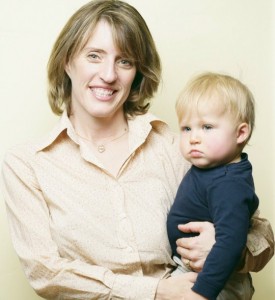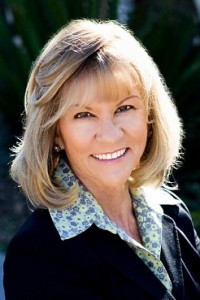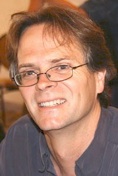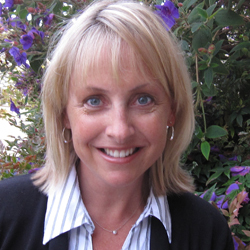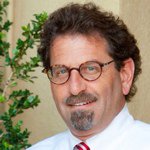Few things in life are better than a fine glass of wine paired with good conversation. Leslie Dinaberg gets a double dose of both when she sits down with K. Reka Badger and Cheryl Crabtree, authors of the new book, California Directory of Fine Wineries.
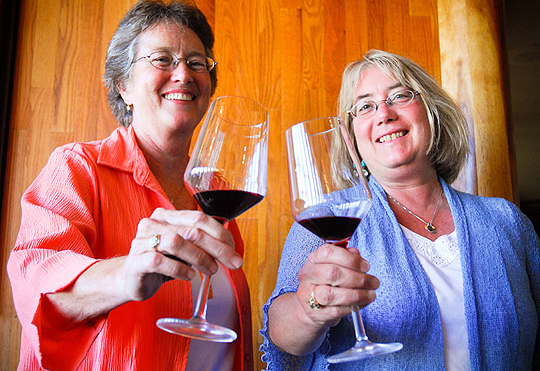
For Reka Badger, left, and Cheryl Crabtree, writing the California Directory of Fine Wineries was a labor of love — and red wine. (Lara Cooper / Noozhawk photo)
Leslie Dinaberg: The California Directory of Fine Wineries book is quite lovely and takes you on a journey through 58 wineries in Santa Barbara County, San Luis Obispo and Paso Robles. How did you decide which wineries to include?Cheryl Crabtree: (Our editor) Tom Silberkleit picked them.LD: Do you know how he picked them?Reka Badger: He tasted all over the place.
CC: He researched heavily.
RB: He chose them for the wine and the quality of the destination.
CC: It had to have a double package … these were destination travel pieces more than wine experiences. He definitely did his homework.
LD: Both of you have written extensively about wine. Tell me about some favorites you discovered in the course of writing the book.
RB: I thought Whalebone’s wines were really good. There was something about knowing their stories that added such a dimension to tasting the wine, too. The guy who owns Whalebone, Bob Simpson, was an obstetrician, and he lost his fingers in a hunting accident and had to do something else. He got involved with vineyards by doing something that was similar to what he did as a doctor, using equipment. They were raising cattle, as well, so they were already kind of farmer types. Then he planted some vineyards and grapes. He’s so devoted to farming … and I liked their wines.
I thought Calcareous Vineyard was a wonderful story — those two sisters (Dana Brown and Erika Messer), and I thought the wines were really nice. Those Zinfandels really showed what you could do with zin. Their pinot … there really is pinot up there in the right spot. I could go on and on.
LD:: What about you, Cheryl? Did you have any discoveries?
CC: I did discover probably one of the best wineries here, Kenneth Volk Vineyards.
LD: Really?
CC: Kenneth Volk is a pioneer in the wine business. He started Wild Horse Winery up in Templeton. He was one of the first and he’s very academic.
RB: He loves to talk about it. He loves to tell you about it.
CC: He’s a scientist, but he loves experimentation. What happened with Wild Horse is, it got a little too big for him and he wanted to return to making just the wines he really wanted to make and experiment with. He’s got 16 or 20 different wines. Some are really unusual ones, from really unusual varietals. Those wines were really good. I loved seeing how much he loves to get his hands dirty and experiment. It’s like a kid with a chemistry kit.
LD: Is this book something people would use to map out their wine-tasting destinations?
RB: It gives a series of really good starting points. I think the purpose is to get people out there, give them an idea of what they might find, and then from there, they can do their own exploring. It’s not a comprehensive guide, but it can point you to some of your favorites and to some that you don’t know.
CC: And to make it seem accessible, because a lot of people who don’t come from California especially think, oh, it’s only for connoisseurs. But that’s not the case at all. The photos really show that. Just normal people learning about wine in a very informal, casual way.
LD: Let’s say, for example, Reka: Where would you take a friend from out of town if you were to go wine tasting?
RB: That’s a really tough one. I would want them to stay five days and we would go to five different regions.
LD:: Really?
RB: Yes. Because there’s a lot of driving involved in the western Paso Robles area, near Whalebone. Vina Robles emerged full-blown from the soil with all of this stacked stone and expensive state-of-the-art stuff, which I steer clear of usually. They usually look too fancy for me, but it was a fabulous experience.
Where we would go would depend on whether we were going to taste some wine or we were going to stop and have a picnic. L’Adventure is at the end of the road. It’s this crazy French guy (Stephen Asseo) who didn’t want to be restricted to the Bordeaux requirements for blending. He wanted to develop blends around cabernets, so he came over here and bought that property. It’s an adventure just getting there. If you want to take a ride and see some country, I would want to go out there. If it’s a short time, I would go someplace a little closer. If there’s no time at all, go down to downtown Paso Robles and just do the downtown.
CC: Same thing, downtown Solvang and downtown Santa Barbara, the Urban Wine Trail. If you have little time, I would focus on those because you can still taste some great wines and walk.
LD: Do you guys have a favorite wine? You mentioned you like reds, Reka.
RB: I do, but depending on the weather and what I’m doing and the time of day. Mornings I prefer champagne, definitely. Late afternoon hot, I love a real crisp rose; I really like the roses a lot, but I do like a red.
LD: What about you, Cheryl?
CC: Pinot Noir. There are several great Pinot Noirs from the Santa Rita Hills. Those are stellar. Kris Curran; anything she touches is wonderful. And she is married to Bruno D’Alfonso, who was (the winemaker) at Sanford for a long time. They now have their own label, D’Alfonso-Curran Wines, but she also is the winemaker for Foley. She works wonders; it doesn’t matter who she’s working for, just find Kris Curran. And she and Bruno have a tasting room in Solvang, too.
LD: I’ll have to remember that.
CC: She is incredible. And so is Bruno. They are, he’s a pioneer also. They helped pave the way. He was the one who crafted Sanford wines for years. But my favorite is Alma Rosa Chardonnay. That’s what we always buy.
RB: Is it pretty affordable?
CC: It’s $11.99 at Costco.
LD: Where’s your favorite place to enjoy a glass of wine?
RB: I have a zero gravity chair, and I sit out on the patio and I kick my feet up and that’s about it. How about you, Cheryl?
CC: Well, I haven’t gotten out much except to my patio, but if I could my favorite view is Ellwood Bluffs. But I’m not sure you can bring wine up there.
RB: Well, if you’re discreet. (Laughs)
CC: That’s where I would go if I had the time. Anywhere with a view around here is not hard to find. Have you ever been to Clautiere Vineyard in Paso Robles? The tasting room has wigs and you put the different wigs on and be whoever you are, wander around the grounds with these wigs and it’s like a French cabaret.
LD: What a hoot. I’ve never heard of that.
RB: You know winemakers are all eccentrics, really.
CC: They really are.
LD: The other part of this is I ask you two a few questions about yourselves. So, Reka, what else do you like to do when you’re not working?
RB: One of my favorite things is to dig holes and plant things. I love to get out there with a shovel and a hat and dig holes and plant. I’m an irrepressible gardener. I love to read, I love to swim, I like to travel but I don’t get to do enough of that now. When the wine runs out I like a nice cold Bombay Martini straight up.
CC: If I had time I would have a list of things that I used to do.
RB: What’s at the top of the list?
CC: Travel. I love to walk the dog and enjoy Santa Barbara. All of these wonderful open spaces that we have. We’re so lucky to be able to have that. Every day we can go to the Douglas Preserve or Hendry’s Beach or the Bluffs or the burned-out trails, but they’re kind of fun still; it’s unusual. It’s a different look but it’s interesting. Also, recently I’ve begun to really like watching water polo.
RB: Isn’t it weird to be interviewed? It’s very strange to be on the other side.
CC: Yeah, it’s peculiar.
LD: If you could pick three adjectives to describe yourself, what would they be?
RB: Gorgeous, confident, wealthy. Put that.
CC: You can think of those for us.
RB: Yeah, just look at us. Curious, driven; those are the only two I can think of.
CC: Stubborn, persistent.
RB: I think we’re going to go with two adjectives each since there are two of us.
Vital Stats: Cheryl Crabtree
Born: July 21, in ancient times, San Francisco
Family: Husband Chris; sons Cameron, 15, and Colin, 10; Lightning the Jack Russell terrier and cats Pepper and Lorraine
Civic Involvement: Hope School District Educational Foundation, volunteer for kids’ sports teams
Professional Accomplishments: BA Stanford University with Honors in humanities and comparative literature; graduate studies in comparative literature at New York University. Moved to Santa Barbara in 1983 to work for EF (Education First). “When the headquarters (and my writing job) moved to Boston in the late ‘80s, I decided to freelance until I found a ‘real’ job. Two decades later, I still don’t have a real job, but I’ve written tons of things.” This includes co-authoring the first edition of The Insider’s Guide to Santa Barbara; working for Fodor’s Travel Publications updating the Central Coast and Monterey Bay chapters in Fodor’s California guidebook since 2001; co-authoring Hometown Santa Barbara (with Noozhawk’s Leslie Dinaberg and Zak Klobucher, and Nancy Ransohoff and Starshine Roshell) and co-authoring “California Directory of Fine Wineries. Story editor/writer Montecito Magazine, writer for Santa Barbara Seasons/Custom Media and writer for the Santa Barbara Conference & Visitors Bureau’s new Santa Barbara visitor’s magazine.
Best Book You’ve Read Recently: Deeply Rooted: Unconventional Farmers in the Age of Agribusiness by Lisa M. Hamilton; Out Stealing Horses by Per Petterson; The Little Book by Selden Edwards
Little-Known Fact “I spent a year in Norway as a high school exchange student and speak Norwegian. Heia Norge!”
Vital Stats: K. Reka Badger
Born: June 12, midcentury last, in Monterey Park
Family: Married 21 years to Jon Budac; two cats and a ball-crazy whippet
Civic Involvement: Creston Garden Club, Santa Barbara Botanic Garden, former board member Santa Barbara County Vintners’ Association
Professional Accomplishments: BA in cultural anthropology from UCSB. “I have worked a lot of different jobs, including driving a cab, making documentary films, building models for an animator, painting houses, writing celebrity bios and managing winery tasting rooms. Currently, I write weekly wine, food and garden-related columns (for the Santa Barbara News-Press and the Santa Maria Sun), and consider the publication of this book a landmark accomplishment.”
Best Book You’ve Read Recently: Pillars of the Earth, by Ken Follett; Mother of Pearl, by Melinda Haynes; The Good Earth, by Pearl S. Buck
Little-Known Fact: “I managed a little copy kiosk at the edge of the UCSB campus way back when and was among Kinko’s first handful of employees.”
Originally published on Noozhawk.com on August 2, 2009.

